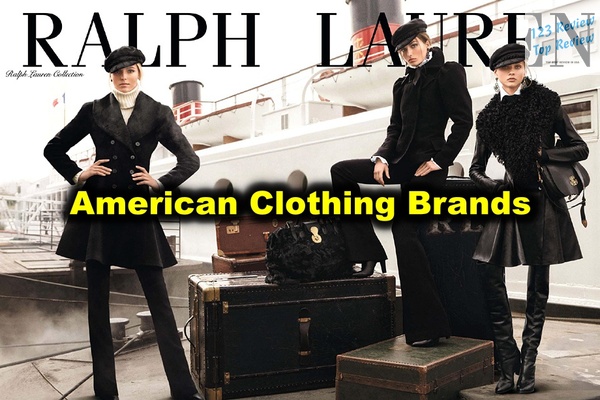As a global fashion hub, the United States has produced some of the most influential brands that not only dictate trends domestically but also shape the fashion narrative worldwide. In 2024, American fashion continues to be a testament to innovation, cultural influence, and adaptability.

In this article, 123 Review delves into the top American clothing brands, the unique characteristics of American fashion, the marketing strategies employed by these brands, consumer trends, and what the future holds for American fashion.
Top American Clothing Brands in 2024
Leading High-End Fashion Brands
In 2024, the American high-end fashion scene is dominated by a mix of legacy brands and contemporary luxury labels. Among these, Ralph Lauren, Calvin Klein, and Tommy Hilfiger stand out as pillars of American fashion, each offering a distinct aesthetic that resonates with a global audience.
- Ralph Lauren: Founded in 1967, Ralph Lauren has become synonymous with timeless American elegance. The brand’s Polo Ralph Lauren line epitomizes preppy, all-American style, with its iconic polo shirts, tailored blazers, and classic denim. Ralph Lauren’s luxury collections, including Purple Label, continue to cater to the elite, offering impeccably crafted suits, evening wear, and accessories. In recent years, the brand has expanded its influence through home decor and fragrances, further solidifying its status as a lifestyle brand.
- Calvin Klein: Known for its minimalist aesthetic and provocative marketing, Calvin Klein remains a force in the fashion industry. The brand’s underwear and jeans lines have achieved cult status, largely due to iconic ad campaigns featuring celebrities like Brooke Shields and Mark Wahlberg. In 2024, Calvin Klein continues to push boundaries with its sleek, modern designs, often characterized by clean lines, neutral color palettes, and a focus on comfort. The brand’s ability to blend simplicity with sex appeal ensures its enduring popularity.
- Tommy Hilfiger: With its red, white, and blue logo, Tommy Hilfiger is a symbol of classic American style. The brand’s designs are heavily influenced by Americana and pop culture, often featuring bold stripes, star motifs, and vibrant colors. Over the years, Tommy Hilfiger has successfully collaborated with artists, musicians, and celebrities, such as Zendaya and Gigi Hadid, to create capsule collections that appeal to younger audiences. The brand’s global reach and ability to stay relevant through strategic partnerships make it a leader in the high-end fashion segment.
Popular Streetwear Brands
Streetwear, once a subculture, has now become a mainstream fashion movement, with several American brands at the forefront. These brands have not only captured the attention of youth culture but have also gained recognition in the luxury fashion world.
- Supreme: Originally a small skate shop in New York City, Supreme has transformed into a global streetwear phenomenon. The brand is known for its limited-edition drops, where products often sell out within minutes. Supreme’s collaborations with other major brands, such as Nike, Louis Vuitton, and The North Face, have elevated it to cult status, making its box logo one of the most coveted symbols in streetwear. Despite its exclusivity, Supreme maintains a strong connection to its roots, continuing to influence skate culture and street fashion.
- Off-White: Founded by the late Virgil Abloh, Off-White is a brand that straddles the line between streetwear and high fashion. Abloh’s background in architecture is evident in the brand’s design language, which often features industrial motifs, such as zip ties, hazard stripes, and bold typography. Off-White’s collaborations with brands like Nike and Ikea, as well as its influence on luxury fashion, have solidified its position as a leader in the streetwear movement. The brand’s ability to merge urban style with avant-garde design continues to attract a diverse audience.
- Fear of God: Established by Jerry Lorenzo, Fear of God is a brand that embodies the concept of luxury streetwear. Lorenzo’s designs are known for their oversized silhouettes, neutral color palettes, and high-quality materials, blending elements of street style with a sophisticated edge. Fear of God’s collaborations with Nike, as well as its mainline collections, have garnered a loyal following among fashion enthusiasts and celebrities alike. The brand’s commitment to craftsmanship and detail ensures its place at the top of the streetwear hierarchy.
Sustainable American Clothing Labels
As environmental concerns become increasingly prominent, the demand for sustainable fashion has grown, leading many American brands to adopt eco-friendly practices. Several brands have emerged as leaders in this space, focusing on ethical production and sustainable materials.
- Patagonia: A pioneer in sustainable fashion, Patagonia has long been committed to environmental activism. The brand, known for its outdoor apparel, emphasizes the use of recycled and organic materials in its products. Patagonia’s commitment to sustainability extends beyond its products; the brand actively engages in environmental campaigns, advocating for the preservation of natural habitats and promoting ethical business practices. In 2024, Patagonia continues to innovate with its Worn Wear program, which encourages customers to repair, reuse, and recycle their clothing, further reducing environmental impact.
- Everlane: Everlane is a brand that has built its reputation on transparency and sustainability. The brand’s “radical transparency” approach provides consumers with detailed information about the costs and production processes behind each product. Everlane focuses on creating high-quality basics, such as t-shirts, jeans, and outerwear, using sustainable materials like organic cotton and recycled polyester. The brand’s commitment to ethical manufacturing and its efforts to reduce waste resonate with environmentally conscious consumers.
- Reformation: Reformation is a brand that has successfully combined sustainability with style. Known for its trendy, feminine designs, Reformation uses sustainable fabrics, such as Tencel, organic cotton, and deadstock fabrics, to create its collections. The brand’s focus on reducing its carbon footprint, water usage, and waste, along with its transparency in reporting its environmental impact, has made it a favorite among eco-conscious fashionistas. In 2024, Reformation continues to expand its offerings, including size-inclusive collections and bridal wear, all while maintaining its commitment to sustainability.
Key Characteristics of American Fashion
Influence of American Culture on Fashion
American fashion is deeply intertwined with the country’s cultural diversity and rich history. The United States, often referred to as a melting pot, has a unique ability to blend various cultural influences into its fashion landscape, resulting in a style that is both diverse and inclusive.
- Pop Culture and Fashion: Pop culture has always played a significant role in shaping American fashion. From Hollywood movies and TV shows to music and sports, various aspects of pop culture have influenced fashion trends in the United States. For instance, the 1950s saw the rise of rock ‘n’ roll, which introduced rebellious styles like leather jackets and skinny jeans. The 1990s were marked by the grunge movement, with flannel shirts, ripped jeans, and combat boots becoming fashion staples. Today, American fashion continues to draw inspiration from pop culture, with brands collaborating with artists, musicians, and actors to create collections that resonate with a broad audience.
- Diverse Regional Styles: The vast geographical landscape of the United States has given rise to distinct regional fashion styles. The East Coast, particularly New York City, is known for its sophisticated, urban fashion, often characterized by tailored clothing, monochromatic color schemes, and a polished aesthetic. In contrast, the West Coast, influenced by the laid-back lifestyle of California, favors casual, comfortable clothing, such as jeans, t-shirts, and sneakers. The South has its own unique style, blending traditional Southern charm with contemporary influences, resulting in preppy, feminine designs often featuring bright colors and floral patterns.
The Role of American Fashion Weeks
Fashion weeks are critical in the global fashion industry, serving as platforms for designers to showcase their latest collections and set trends for the upcoming seasons. American fashion weeks, particularly New York Fashion Week, hold a special place in the industry, attracting attention from fashion enthusiasts, editors, and buyers worldwide.
- New York Fashion Week: As one of the “Big Four” fashion weeks (alongside Paris, Milan, and London), New York Fashion Week is a major event on the fashion calendar. It is known for its diverse lineup of designers, from established fashion houses to emerging talent. The week-long event features runway shows, presentations, and parties, where the latest trends are unveiled to the world. New York Fashion Week is also a significant platform for American designers to gain international recognition, with many brands using the event to debut innovative designs and collaborations.
- Los Angeles and Miami Fashion Weeks: While New York is the epicenter of American fashion, other cities like Los Angeles and Miami are also making their mark. Los Angeles Fashion Week is known for its focus on sustainable fashion and up-and-coming designers, reflecting the city’s progressive and eco-conscious ethos. Miami Fashion Week, on the other hand, is a celebration of resort wear and swimwear, influenced by the city’s tropical climate and vibrant culture. Both fashion weeks offer a glimpse into the regional diversity of American fashion, showcasing the unique styles and trends that define each city.
Marketing Strategies Used by American Clothing Brands
Social Media Marketing Techniques
In the digital age, social media has become an indispensable tool for fashion brands to connect with consumers, build brand identity, and drive sales. American clothing brands, in particular, have mastered the art of social media marketing, using platforms like Instagram, TikTok, and Pinterest to reach their target audiences.
- Instagram: Instagram is one of the most popular platforms for fashion brands, offering a visually-driven space to showcase products, share behind-the-scenes content, and engage with followers. Brands like Nike, Adidas, and Levi’s use Instagram to create visually appealing content that resonates with their audience. Through carefully curated feeds, Instagram Stories, and IGTV, these brands can tell their story, promote new collections, and build a loyal community of followers. The platform’s shopping feature also allows brands to sell products directly to consumers, making it a valuable tool for driving sales.
- TikTok: TikTok has rapidly become a key platform for fashion brands, particularly those targeting Gen Z. The platform’s short-form video content allows brands to engage with younger audiences through creative, often viral, content. Brands like American Eagle and Guess have leveraged TikTok’s trend-driven nature to launch challenges, collaborate with influencers, and showcase their latest collections in a fun, relatable way. TikTok’s algorithm, which promotes content based on user engagement, provides brands with the opportunity to reach a vast audience quickly, making it an essential part of any modern marketing strategy.
- Pinterest: Pinterest is another platform that fashion brands use to inspire and engage with consumers. Known for its highly visual, search-driven interface, Pinterest is ideal for brands looking to share style inspiration, trend forecasts, and curated looks. Brands like Anthropologie and Free People use Pinterest to create mood boards, showcase seasonal collections, and drive traffic to their e-commerce sites. The platform’s shoppable pins feature also allows brands to link directly to product pages, making it easy for users to discover and purchase items.
Collaborations with Influencers
Collaborations with influencers have become a cornerstone of modern marketing strategies, allowing brands to tap into the influencer’s audience and gain credibility through association. American clothing brands have been at the forefront of this trend, partnering with influencers to reach new consumers and create buzz around their products.
- Micro-Influencers: Many American brands have recognized the value of micro-influencers—individuals with smaller, highly engaged followings. Micro-influencers often have a more personal connection with their audience, making their endorsements feel more authentic and trustworthy. Brands like Madewell and Glossier have successfully partnered with micro-influencers to promote their products, using the influencers’ content across social media channels and in marketing campaigns.
- Celebrity Collaborations: On the other end of the spectrum, collaborations with celebrities and high-profile influencers continue to be a popular strategy for American clothing brands. For example, American Eagle has partnered with celebrities like Lil Wayne and Madison Beer to create exclusive collections and generate media attention. Similarly, brands like Coach and Guess have launched successful campaigns featuring global icons like Jennifer Lopez and Hailey Bieber. These collaborations not only boost brand visibility but also align the brand with the influencer’s image, appealing to their fan base.
Consumer Trends in American Apparel
Rise of E-commerce in Fashion
E-commerce has revolutionized the fashion industry, changing the way consumers shop for clothing. In 2024, online shopping is more popular than ever, with American clothing brands investing heavily in their digital platforms to meet consumer demand.
- User Experience: To stand out in the crowded online marketplace, American brands are focusing on enhancing the user experience on their websites and mobile apps. Brands like Nordstrom and Urban Outfitters have developed intuitive, user-friendly platforms that offer personalized shopping experiences. Features like AI-driven product recommendations, virtual try-ons, and seamless checkout processes make it easier for consumers to find and purchase products online.
- Omnichannel Strategies: Many American clothing brands are adopting omnichannel strategies to provide a cohesive shopping experience across multiple touchpoints. This approach allows consumers to shop seamlessly between online and offline channels. For example, brands like Macy’s and Gap offer services such as buy online, pick up in-store (BOPIS), and curbside pickup, giving customers the convenience of shopping online with the immediacy of in-store pickup. Additionally, these brands are integrating their online and offline inventories, ensuring that customers have access to the full range of products, regardless of where they choose to shop.
- Subscription Services: Subscription-based fashion services are also gaining popularity in the American market. Brands like Stitch Fix and Rent the Runway offer personalized clothing selections delivered directly to the consumer’s door. These services cater to the growing demand for convenience and personalization, allowing consumers to try new styles without the commitment of a traditional purchase. As e-commerce continues to evolve, subscription services are likely to become an integral part of the fashion shopping experience.
Growing Demand for Sustainable Fashion
The fashion industry is facing increasing scrutiny for its environmental impact, leading to a growing demand for sustainable fashion. American consumers are becoming more conscious of the environmental and social implications of their purchasing decisions, driving brands to adopt more sustainable practices.
- Ethical Production: One of the key aspects of sustainable fashion is ethical production, which involves ensuring fair labor practices and safe working conditions in the supply chain. Brands like Levi’s and Eileen Fisher are committed to transparency in their production processes, working with factories that adhere to strict ethical standards. These brands often highlight their commitment to ethical production in their marketing, appealing to consumers who prioritize social responsibility in their purchasing decisions.
- Sustainable Materials: The use of sustainable materials is another important factor in the shift towards eco-friendly fashion. Brands like Patagonia and Reformation are leading the way in using recycled, organic, and biodegradable materials in their collections. These brands are also investing in innovative fabrics, such as Tencel and Econyl, which have a lower environmental impact compared to traditional materials like cotton and polyester. By focusing on sustainable materials, American clothing brands are not only reducing their environmental footprint but also meeting the growing consumer demand for eco-friendly products.
- Circular Fashion: Circular fashion, which involves extending the lifecycle of garments through recycling, reusing, and upcycling, is gaining traction in the American market. Brands like Patagonia’s Worn Wear and Levi’s SecondHand are pioneering circular fashion initiatives, offering customers the opportunity to buy and sell used clothing. These programs not only promote sustainability but also provide an affordable option for consumers looking to purchase high-quality, pre-owned items. As the demand for sustainable fashion continues to rise, more American brands are likely to embrace circular fashion as part of their business model.
Comparison of American and Global Clothing Brands
Unique Aspects of American Style
American fashion is known for its practicality, versatility, and emphasis on individuality, which sets it apart from other global fashion markets. Unlike European fashion, which often focuses on high-end luxury and intricate craftsmanship, American style is more relaxed and adaptable, catering to a wide range of lifestyles and preferences.
- Casual Wear: One of the defining characteristics of American fashion is its emphasis on casual wear. Items like jeans, t-shirts, and sneakers are staples in the American wardrobe, reflecting the country’s laid-back, casual culture. Brands like Levi’s, Converse, and Vans have become iconic symbols of American style, with their products being worn by people of all ages and backgrounds. The popularity of casual wear in the United States has also influenced global fashion trends, with many international brands incorporating elements of American style into their collections.
- Individuality and Self-Expression: American fashion is also known for its celebration of individuality and self-expression. The diverse cultural landscape of the United States allows for a wide range of styles and influences, from the punk rock scene of the 1970s to the hip-hop culture of the 1980s and 1990s. This emphasis on personal style has led to the rise of niche fashion movements, such as streetwear, athleisure, and vintage fashion, each offering a unique way for individuals to express themselves through clothing.
Challenges Faced by American Brands in the Global Market
While American clothing brands are widely recognized and respected, they face several challenges in the global market. Competition from fast fashion giants, cultural differences, and the need to adapt to changing consumer preferences are among the key obstacles that American brands must navigate.
- Competition from Fast Fashion: Fast fashion brands like Zara, H&M, and Uniqlo pose a significant challenge to American clothing brands. These international giants offer trendy, affordable clothing with a rapid turnaround, appealing to consumers who seek the latest styles at lower prices. To compete, American brands must find ways to differentiate themselves, whether through superior quality, unique designs, or a focus on sustainability. Additionally, American brands may need to adapt their pricing strategies and supply chains to remain competitive in the fast-paced global market.
- Cultural Differences: Expanding into international markets requires American clothing brands to navigate cultural differences and adapt their products to local preferences. For example, a brand that is popular in the United States may need to modify its designs, sizing, or marketing strategies to appeal to consumers in Asia, Europe, or the Middle East. Understanding and respecting cultural nuances is crucial for American brands looking to succeed in the global market.
- Changing Consumer Preferences: The fashion industry is constantly evolving, with consumer preferences shifting rapidly. American clothing brands must stay ahead of these trends to remain relevant in the global market. This includes responding to the growing demand for sustainability, embracing new technologies, and catering to the diverse needs of consumers. Brands that fail to adapt may struggle to maintain their market share in an increasingly competitive landscape.
Future Outlook for American Clothing Brands
Innovations in Textile and Design
The future of American fashion is being shaped by innovation, particularly in the areas of textile development and design. As technology advances, American clothing brands are exploring new materials and techniques that could revolutionize the industry.
- Smart Textiles: One of the most exciting developments in textile innovation is the rise of smart textiles—fabrics that can interact with the wearer or the environment. These textiles may have the ability to change color, regulate temperature, or even monitor health metrics. For example, brands like Under Armour are experimenting with performance fabrics that enhance athletic performance by wicking away moisture and providing targeted compression. As smart textiles become more advanced, they have the potential to create entirely new categories of clothing, offering consumers functionality and convenience like never before.
- Sustainable Innovations: Sustainability continues to be a driving force behind innovation in the fashion industry. American brands are experimenting with new ways to create eco-friendly textiles, such as biodegradable fabrics made from natural fibers or lab-grown leather alternatives. Additionally, advancements in recycling technology are enabling brands to repurpose textile waste into new garments, reducing the environmental impact of clothing production. These innovations not only contribute to a more sustainable fashion industry but also give American brands a competitive edge in the global market.
Global Expansion and Adaptation
As American clothing brands look to the future, global expansion remains a key focus. However, success in international markets requires careful adaptation to local cultures and consumer preferences.
- Customization for Local Markets: To succeed globally, American clothing brands must tailor their products and marketing strategies to meet the needs of different regions. This may involve creating region-specific collections, adjusting sizing to accommodate local body types, or incorporating cultural elements into designs. For example, a brand entering the Asian market might offer smaller sizes or introduce clothing lines that cater to regional fashion trends. By customizing their offerings, American brands can build stronger connections with international consumers and increase their market share.
- E-commerce Expansion: The rise of e-commerce presents a significant opportunity for American clothing brands to expand their global reach. Online platforms allow brands to reach consumers in markets where they may not have a physical presence, offering a convenient way to shop for American fashion. To capitalize on this opportunity, brands must invest in robust e-commerce infrastructure, including localized websites, efficient logistics, and customer service that can cater to different time zones and languages. By leveraging e-commerce, American clothing brands can access new markets and grow their international customer base.
Conclusion
American clothing brands have a rich history of influencing global fashion trends, from high-end luxury labels to streetwear icons and sustainable pioneers. As the fashion industry continues to evolve, American brands are embracing innovation, sustainability, and global expansion to stay ahead of the curve. Whether through the development of smart textiles, the rise of e-commerce, or the growing demand for sustainable fashion, the future of American clothing brands looks bright. As these brands continue to adapt and innovate, they will undoubtedly remain a powerful force in the global fashion landscape for years to come.





